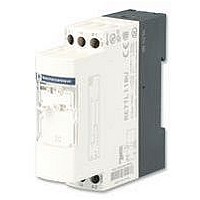RE7TP13BU TELEMECANIQUE, RE7TP13BU Datasheet - Page 3

RE7TP13BU
Manufacturer Part Number
RE7TP13BU
Description
TIMER, ON-DELAY
Manufacturer
TELEMECANIQUE
Datasheet
1.RE7TL11BU.pdf
(22 pages)
Specifications of RE7TP13BU
Contact Configuration
DPCO
Nom Input Voltage
240V
Delay Time Range
0.05s To 300h
Relay Mounting
DIN Rail
Coil Voltage Vac Nom
250V
Contact Current Ac Max
8A
Contact Current Dc Max
8A
2
Functions
On-delay
Off-delay
On and Off-delay
Timing relay with pulse on energisation
Timing relay with pulse on de-energisation or on opening of a external control contact
Flashing relay
Time delay relays for star-delta starters
Multifunction relays
On-delay - Pulse on energisation contact - Symmetrical flasher
Same functions as above +
Off-delay - Pulse on energisation contact with externally controlled start - Symmetrical flasher
Same functions as above +
Star Delta starting (External control of start of the timing period is not possible for the star delta starting function).
2/8
Control or
supply
C/O contact
Control or
supply
C/O contact
Control or
supply
C/O contact
Supply
C/O contact
Control or
supply
C/O contact
Supply
C/O contact
Supply
Star
Delta
Te
Diagram
t
t
ta
t
ta
t3
tr
t
tr
t
Zelio Time - timing relays
Functions and selection
Operating principle
Timing starts when the relay is energised. When the set time delay (t) has elapsed, the output contact closes. When the
relay is de-energised, the contact returns to its initial position. The output contact does not close if the duration of the
control instruction is less than the set time delay.
Timing can also be started by opening of a control contact (models with external control).
Energisation of the relay or closing of the control contact (models with external control) causes the output relay to close
instantaneously . Timing starts when the relay is de-energised or when the control contact opens. When the set time delay
(t) has elapsed, the contact returns to its initial position. If the energisation time or closing time of the control contact i s
less than the minimum time specified, the timing period does not start.
This function is a combination of the
On and Off delay functions. The timing
cycle must be controlled by an external
contact.
Energisation of the relay causes the output contact to close instantaneously and start the timing period. The contact
returns to its initial position when the set time delay (t) has elapsed or if the supply is cut off before the end of the timing
period.
De-energisation of the relay or opening of the external control contact (depending on model) causes the output contact
to close instantaneously and start the timing period. When the set time delay (t) has elapsed, the contact returns to its
initial position.
Energisation of the relay starts the
flashing period and causes the output
relay to start the flashing cycle. When
the relay is de-energised, the contact
returns to its initial position.
Energisation of the relay causes the star contactor to close instantaneously and starts the timing period. When the set
time delay (t) has elapsed, the star contactor returns to its initial position and the delta contactor closes, after a breaking
time sufficient for the changeover.
Symmetrical
Asymmetrical
The On and Off delays are adjusted by 2 different potentiometers.
Symmetrical flashing relay
The On and Off flashing phases are identical.
Asymmetrical flashing relay
The On and Off flashing phases are adjusted by 2 different potentiometers
(ta and tr).
The On and Off delays are equal.





















